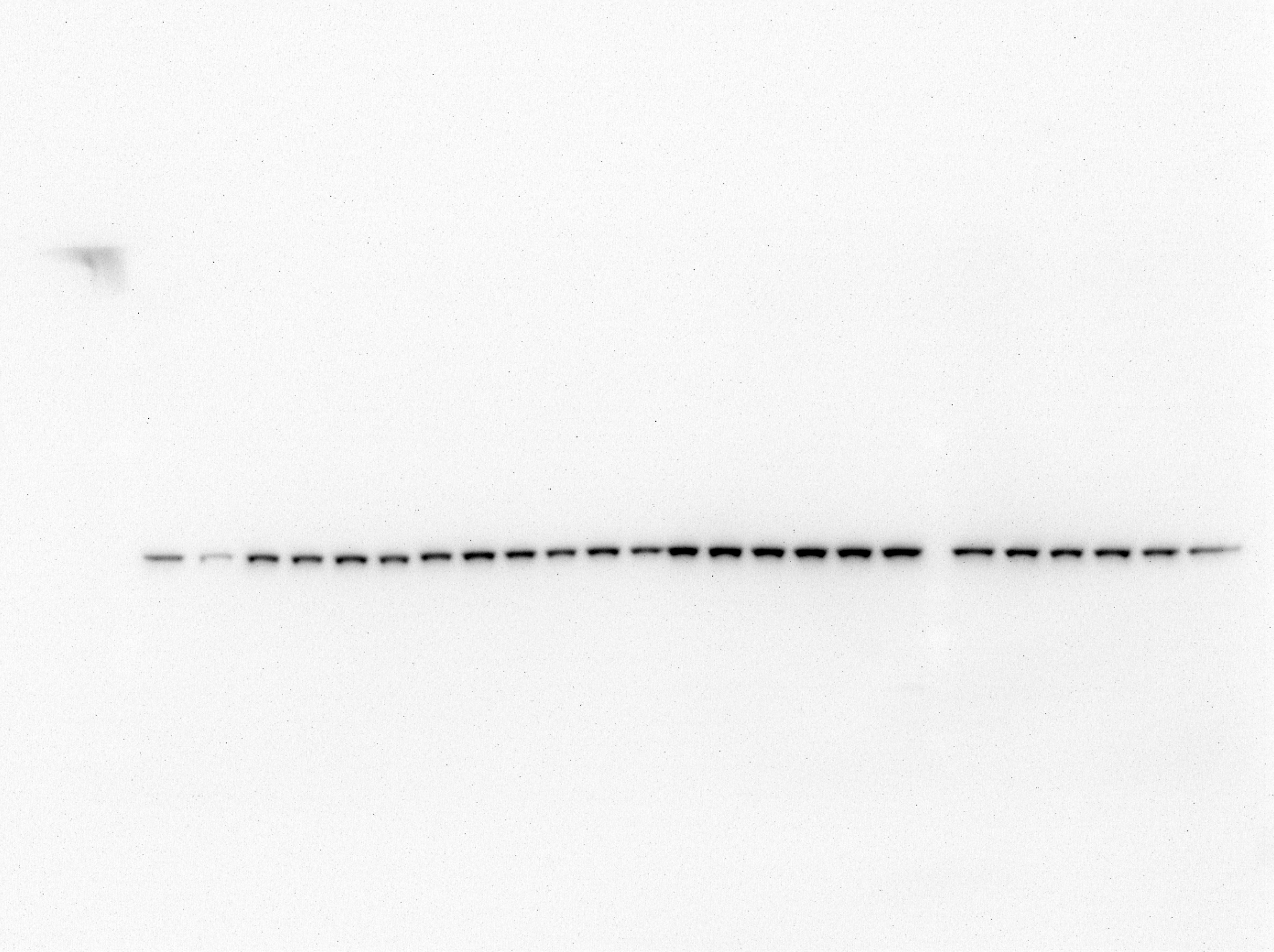Human/Mouse/Rat GAPDH Antibody Summary
Met1-Ala150
Accession # P04406
Applications
Please Note: Optimal dilutions should be determined by each laboratory for each application. General Protocols are available in the Technical Information section on our website.
Scientific Data
 View Larger
View Larger
Detection of Human, Mouse, and Rat GAPDH/G3PDH by Western Blot. Western blot shows lysates of human brain tissue, mouse brain tissue, and rat brain tissue. PVDF Membrane was probed with 0.05 µg/mL of Mouse Anti-Human/Mouse/Rat GAPDH/G3PDH Monoclonal Antibody (Catalog # MAB5718) followed by HRP-conjugated Anti-Mouse IgG Secondary Antibody (Catalog # HAF007). A specific band was detected for GAPDH/G3PDH at approximately 39 kDa (as indicated). This experiment was conducted under reducing conditions and using Immunoblot Buffer Group 2.
 View Larger
View Larger
GAPDH in HeLa Human Cell Line. GAPDH was detected in immersion fixed HeLa human cervical epithelial carcinoma cell line using Mouse Anti-Human/Mouse/Rat GAPDH Monoclonal Antibody (Catalog # MAB5718) at 8 µg/mL for 3 hours at room temperature. Cells were stained using the NorthernLights™ 557-conjugated Anti-Mouse IgG Secondary Antibody (red; Catalog # NL007) and counterstained with DAPI (blue). View our protocol for Fluorescent ICC Staining of Cells on Coverslips.
 View Larger
View Larger
GAPDH/G3PDH in Human Kidney. GAPDH/G3PDH was detected in immersion fixed paraffin-embedded sections of human kidney using Mouse Anti-Human/Mouse/Rat GAPDH/G3PDH Monoclonal Antibody (Catalog # MAB5718) at 15 µg/mL overnight at 4 °C. Before incubation with the primary antibody, tissue was subjected to heat-induced epitope retrieval using Antigen Retrieval Reagent-Basic (Catalog # CTS013). Tissue was stained using the Anti-Mouse HRP-DAB Cell & Tissue Staining Kit (brown; Catalog # CTS002) and counterstained with hematoxylin (blue). Specific staining was localized to cytoplasm and nuclei. View our protocol for Chromogenic IHC Staining of Paraffin-embedded Tissue Sections.
 View Larger
View Larger
Detection of Human and Mouse GAPDH/G3PDH by Simple WesternTM. Simple Western lane view shows lysates of Jurkat human acute T cell leukemia cell line and C2C12 mouse myoblast cell line, loaded at 0.2 mg/mL. A specific band was detected for GAPDH/G3PDH at approximately 41 kDa (as indicated) using 0.25 µg/mL of Mouse Anti-Human/Mouse/Rat GAPDH/G3PDH Monoclonal Antibody (Catalog # MAB5718). This experiment was conducted under reducing conditions and using the 12-230 kDa separation system.
 View Larger
View Larger
Detection of Human, Mouse, and Rat GAPDH by Simple WesternTM. Simple Western lane view shows lysates of Jurkat human acute T cell leukemia cell line, HeLa human cervical epithelial carcinoma cell line, C2C12 mouse myoblast cell line, and C6 rat glioma cell line, loaded at 0.2 mg/mL. A specific band was detected for GAPDH at approximately 42 kDa (as indicated) using 1 µg/mL of Mouse Anti-Human/Mouse/Rat GAPDH Monoclonal Antibody (Catalog # MAB5718). This experiment was conducted under reducing conditions and using the 12-230 kDa separation system.
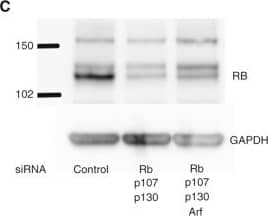 View Larger
View Larger
Detection of Human GAPDH by Western Blot Simultaneous knockdown of multiple genes in primary human islets following electroporation. (A) Graph shows RT-qPCR results of islets electroporated with non-targeting control siRNA or siRNA targeting RB and p130 (L-003299). (B) Graph shows RT-qPCR results of islets electroporated with non-targeted control siRNA or siRNAs targeting the indicated gene products. The housekeeping gene GAPDH was used as the control. Representative experiment shown from 3 separate experiments. Error bars indicate standard deviation. (C) Western blot for RB protein in human islet lysates after electroporation of control or targeting siRNA. GAPDH was used as a loading control. RB appears as a characteristic doublet representing the hypo and hyperphosphorylated protein. Representative experiment shown from 3 different experiments. Image collected and cropped by CiteAb from the following open publication (https://pubmed.ncbi.nlm.nih.gov/25305068), licensed under a CC-BY license. Not internally tested by R&D Systems.
 View Larger
View Larger
Detection of GAPDH by Western Blot Evaluation of CPP/mRNA-mediated protein expression. (A) Representative fluorescence images and a quantitative graph showing mCherry-positive CT26.CL25 cells 24 h after treatment with CPP/mCherry mRNA complexes (6.8 nM). Scale bar: 275 μm. Data are presented as the mean ± SD (n = 3). (B) Representative flow cytometry histograms and graphs of EGFP-positive CL26.CL25 cells transfected with CPP/EGFP mRNA complexes (6.8 nM). Data are presented as the mean ± SD (n = 3). (C) Western blot analysis of the expression levels of OVA and GAPDH in CT26.CL25 cells. Image collected and cropped by CiteAb from the following open publication (https://pubmed.ncbi.nlm.nih.gov/35745843), licensed under a CC-BY license. Not internally tested by R&D Systems.
 View Larger
View Larger
Detection of GAPDH by Western Blot Evaluation of CPP/mRNA-mediated protein expression. (A) Representative fluorescence images and a quantitative graph showing mCherry-positive CT26.CL25 cells 24 h after treatment with CPP/mCherry mRNA complexes (6.8 nM). Scale bar: 275 μm. Data are presented as the mean ± SD (n = 3). (B) Representative flow cytometry histograms and graphs of EGFP-positive CL26.CL25 cells transfected with CPP/EGFP mRNA complexes (6.8 nM). Data are presented as the mean ± SD (n = 3). (C) Western blot analysis of the expression levels of OVA and GAPDH in CT26.CL25 cells. Image collected and cropped by CiteAb from the following open publication (https://pubmed.ncbi.nlm.nih.gov/35745843), licensed under a CC-BY license. Not internally tested by R&D Systems.
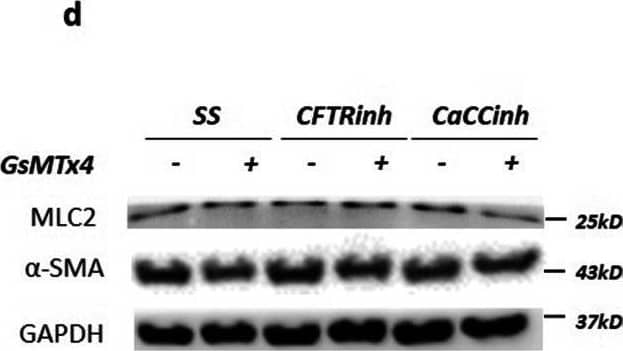 View Larger
View Larger
Detection of GAPDH by Western Blot Molecular effect of intraluminal chloride and GsMTx4 in smooth muscle cells. a-c Upper panel represents the main cumulative effect of intraluminal chloride concentration ([Cl−]) and medium supplementation with and without GsMTx4. a Examples of representative blots are shown. b, c Protein expression levels for b myosin light chain 2 (MLC2), and c alpha-smooth muscle actin ( alpha -SMA) are quantified. d–f Lower panel shows the additional effect of PIEZO1/2 inhibition after intraluminal injection of Cl− channels inhibitors: cystic fibrosis transmembrane conductance regulator inhibitor172 (CFTRinh) to CFTR and; calcium-dependent Cl− channel inhibitor A01 (CaCCinh) to CaCCs. d Examples of representative blots are shown. e–f Relative expression levels of e MLC2, and f alpha -SMA are displayed. 143 mM Cl− and standard solution (SS) represent the control condition for [Cl−] and Cl− channels inhibitors, respectively. White and dotted rectangles represent the medium supplementation with and without GsMTx4, respectively. Each lane represents a pooled-tissue sample, and the relative expression levels were determined against GAPDH. n ≥ 4 were used per antibody/condition. Results are presented as mean ± SD. Symbols indicate the main effects and non-redundant interactions of the two-way ANOVA. p < alpha 0.0001, beta 0.001, gamma 0.01, µ0.05 Image collected and cropped by CiteAb from the following open publication (https://pubmed.ncbi.nlm.nih.gov/36740669), licensed under a CC-BY license. Not internally tested by R&D Systems.
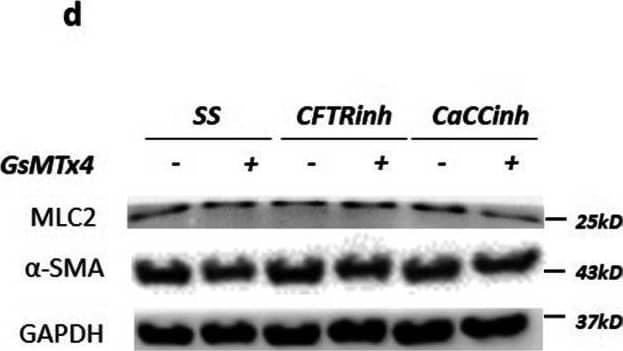 View Larger
View Larger
Detection of GAPDH by Western Blot Molecular effect of intraluminal chloride and GsMTx4 in smooth muscle cells. a-c Upper panel represents the main cumulative effect of intraluminal chloride concentration ([Cl−]) and medium supplementation with and without GsMTx4. a Examples of representative blots are shown. b, c Protein expression levels for b myosin light chain 2 (MLC2), and c alpha-smooth muscle actin ( alpha -SMA) are quantified. d–f Lower panel shows the additional effect of PIEZO1/2 inhibition after intraluminal injection of Cl− channels inhibitors: cystic fibrosis transmembrane conductance regulator inhibitor172 (CFTRinh) to CFTR and; calcium-dependent Cl− channel inhibitor A01 (CaCCinh) to CaCCs. d Examples of representative blots are shown. e–f Relative expression levels of e MLC2, and f alpha -SMA are displayed. 143 mM Cl− and standard solution (SS) represent the control condition for [Cl−] and Cl− channels inhibitors, respectively. White and dotted rectangles represent the medium supplementation with and without GsMTx4, respectively. Each lane represents a pooled-tissue sample, and the relative expression levels were determined against GAPDH. n ≥ 4 were used per antibody/condition. Results are presented as mean ± SD. Symbols indicate the main effects and non-redundant interactions of the two-way ANOVA. p < alpha 0.0001, beta 0.001, gamma 0.01, µ0.05 Image collected and cropped by CiteAb from the following open publication (https://pubmed.ncbi.nlm.nih.gov/36740669), licensed under a CC-BY license. Not internally tested by R&D Systems.
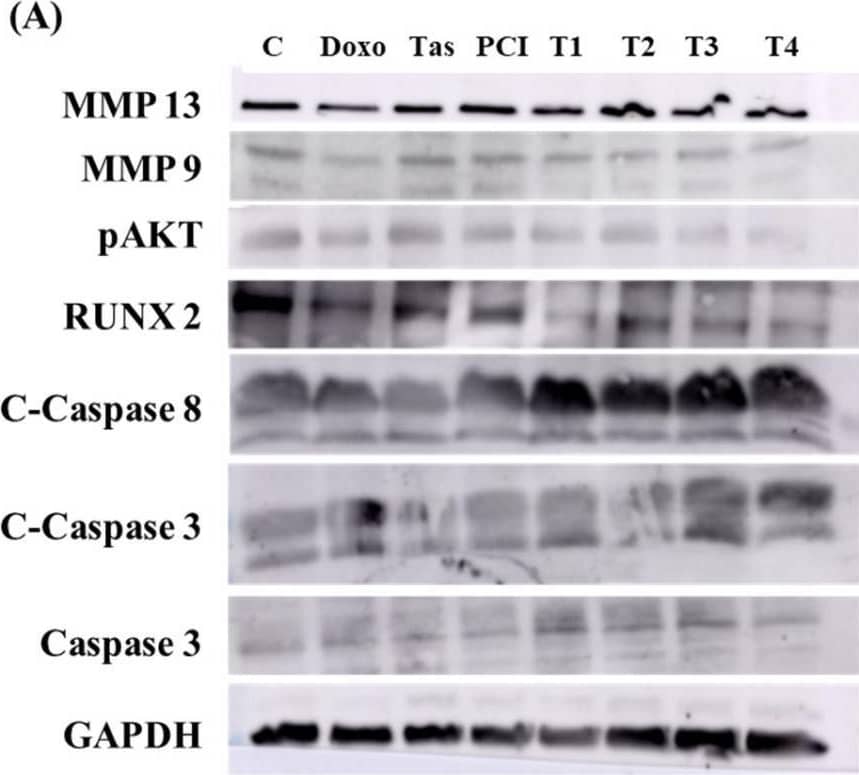 View Larger
View Larger
Detection of GAPDH by Western Blot The impact of combination therapy on protein and gene expression in SJSA-1 osteosarcoma cells. (A) A Western blot analysis illustrating the effects of the combination treatment on key proteins involved in metastasis, cell survival, and apoptosis in SJSA-1 osteosarcoma cells. The expression levels of MMP9 and MMP13, which facilitate tumor cell invasion and metastasis through ECM degradation, were significantly reduced, indicating a potential inhibitory effect of the combination therapy on metastatic progression. Additionally, phosphorylated AKT (pAKT), a central regulator of the PI3K/AKT pathway associated with cell survival and chemoresistance, and runt-related transcription factor 2 (RUNX2), a critical modulator of osteosarcoma progression and tumor aggressiveness, were both downregulated, suggesting the suppression of key oncogenic pathways. Conversely, apoptotic markers, including cleaved caspase-8, cleaved caspase-3, and total caspase-3, exhibited increased activation following treatment, indicating enhanced apoptotic signaling. GAPDH was used as a loading control to ensure equal protein loading across samples. (B) A densitometric analysis of the Western blot bands representing the expression levels of target proteins after 48 h of treatment. The band intensities were quantified using Image Lab software (Version 6.1.0 build 7) and normalized to the GAPDH. Relative protein expression levels are expressed as a fold change compared to the untreated control group. The data represent the mean ± the standard deviation from two independent experiments. (C) qRT-PCR analyzed the gene expression of the apoptosis-related markers p16 and p53 following treatment. The results highlight the upregulation of p16 and stable expression of p53 in treated cells. (* p < 0.05 and ** p < 0.01). Image collected and cropped by CiteAb from the following open publication (https://pubmed.ncbi.nlm.nih.gov/40332124), licensed under a CC-BY license. Not internally tested by R&D Systems.
Reconstitution Calculator
Preparation and Storage
- 12 months from date of receipt, -20 to -70 °C as supplied.
- 1 month, 2 to 8 °C under sterile conditions after reconstitution.
- 6 months, -20 to -70 °C under sterile conditions after reconstitution.
Background: GAPDH
GAPDH (Glyceraldehyde-3-phosphate dehydrogenase) is a 36-40 kDa member of the GAPDH family of enzymes. It is a widely expressed heterotetramer that is found in both the nucleus and cytoplasm. Although GAPDH was initially identified as a glycolytic enzyme that converted G3P into 1,3 diphosphoglycerate, it is now recognized to participate in no less than endocytosis, membrane fusion, vesicular secretory transport, DNA replication and repair, and apoptosis. Human GAPDH is 335 amino acids (aa) in length. There are two NAD binding sites (Asp35 and Asn316) with a catalytic region between aa 151-155. GAPDH contains no fewer that 19 posttranslational modifications, including methylation, deamidation and phosphorylation. One splice variant shows a 10 aa substitution for aa 319‑335. Over
aa 1‑150, human GAPDH shares 92% aa identity with mouse GAPDH.
Product Datasheets
Citations for Human/Mouse/Rat GAPDH Antibody
R&D Systems personnel manually curate a database that contains references using R&D Systems products. The data collected includes not only links to publications in PubMed, but also provides information about sample types, species, and experimental conditions.
41
Citations: Showing 1 - 10
Filter your results:
Filter by:
-
Inducible transgene expression in PDX models in vivo identifies KLF4 as a therapeutic target for B-ALL
Authors: Liu WH, Mrozek-Gorska P, Wirth AK et al.
Biomarker research
-
AAV9-mediated FIG4 delivery prolongs life span in Charcot Marie Tooth disease type 4J mouse model
Authors: Presa M, Bailey RM, Davis C et al.
The Journal of clinical investigation
-
Lamin B1 overexpression alters chromatin organization and gene expression
Authors: Jeanae M. Kaneshiro, Juliana S. Capitanio, Martin W. Hetzer
Nucleus
Species: Human
Sample Types: Cell Lysates
Applications: Western Blot -
Arachidin-1, a Prenylated Stilbenoid from Peanut, Enhances the Anticancer Effects of Paclitaxel in Triple-Negative Breast Cancer Cells
Authors: S Mohammadho, A Weaver, M Sudhakaran, LC Ho, T Le, AI Doseff, F Medina-Bol
Cancers, 2023-01-07;15(2):.
Species: Human
Sample Types: Cell Lysates
Applications: Western Blot -
Hyaluronic acid restored protein permeability across injured human lung microvascular endothelial cells
Authors: Shinji Sugita, Yoshifumi Naito, Li Zhou, Hongli He, Qi Hao, Atsuhiro Sakamoto et al.
FASEB BioAdvances
-
Exosome-guided direct reprogramming of tumor-associated macrophages from protumorigenic to antitumorigenic to fight cancer
Authors: H Kim, HJ Park, HW Chang, JH Back, SJ Lee, YE Park, EH Kim, Y Hong, G Kwak, IC Kwon, JE Lee, YS Lee, SY Kim, Y Yang, SH Kim
Bioactive materials, 2022-08-05;25(0):527-540.
-
Impact of increased APP gene dose in Down syndrome and the Dp16 mouse model
Authors: Mariko Sawa, Cassia Overk, Ann Becker, Dominique Derse, Ricardo Albay, Kim Weldy et al.
Alzheimer's & Dementia
-
G alpha 13 Mediates Transendothelial Migration of Neutrophils by Promoting Integrin-Dependent Motility without Affecting Directionality
Authors: Claire W. Chang, Ni Cheng, Yanyan Bai, Randal A. Skidgel, Xiaoping Du
The Journal of Immunology
-
Dietary Intervention, When Not Associated With Exercise, Upregulates Irisin/FNDC5 While Reducing Visceral Adiposity Markers in Obese Rats
Authors: Vanessa de Oliveira Furino, João Manoel Alves, Diego Adorna Marine, Marcela Sene-Fiorese, Carla Nascimento dos Santos Rodrigues, Cristina Arrais-Lima et al.
Frontiers in Physiology
-
An epigenetic switch regulates the ontogeny of AXL-positive/EGFR-TKi-resistant cells by modulating miR-335 expression
Authors: Polona Safaric Tepes, Debjani Pal, Trine Lindsted, Ingrid Ibarra, Amaia Lujambio, Vilma Jimenez Sabinina et al.
eLife
-
Mass Spectrometric Profiling of Extraocular Muscle and Proteomic Adaptations in the mdx-4cv Model of Duchenne Muscular Dystrophy
Authors: Stephen Gargan, Paul Dowling, Margit Zweyer, Jens Reimann, Michael Henry, Paula Meleady et al.
Life (Basel)
-
Functional Redundancy of Cyclase-Associated Proteins CAP1 and CAP2 in Differentiating Neurons
Authors: F Schneider, I Metz, S Khudayberd, MB Rust
Cells, 2021-06-17;10(6):.
Species: Mouse
Sample Types: Tissue Homogenates
Applications: Western Blot -
Cyclase-associated protein 2 (CAP2) controls MRTF-A localization and SRF activity in mouse embryonic fibroblasts
Authors: LJ Kepser, S Khudayberd, LS Hinojosa, C Macchi, M Ruscica, E Marcello, C Culmsee, R Grosse, MB Rust
Scientific Reports, 2021-02-26;11(1):4789.
Species: Mouse
Sample Types: Cell Lysates
Applications: Western Blot -
Comparative Cell Surface Proteomic Analysis of the Primary Human T Cell and Monocyte Responses to Type I Interferon
Authors: Lior Soday, Martin Potts, Leah M. Hunter, Benjamin J. Ravenhill, Jack W. Houghton, James C. Williamson et al.
Frontiers in Immunology
-
miR-146b Functions as an Oncogene in Oral Squamous Cell Carcinoma by Targeting HBP1
Authors: Kui Li, Zheng Zhou, Ju Li, Rui Xiang
Technol Cancer Res Treat
-
Using chemiluminescence imaging of cells (CLIC) for relative protein quantification
Authors: J Fisher, OE Sørensen, AHA Abu-Humaid
Sci Rep, 2020-10-26;10(1):18280.
Species: Human
Sample Types: Whole Cells
Applications: ICC -
Uniaxial Static Strain Promotes Osteoblast Proliferation and Bone Matrix Formation in Distraction Osteogenesis In Vitro
Authors: Z Li, J Zheng, D Wan, X Yang
Biomed Res Int, 2020-08-12;2020(0):3906426.
Species: Rat
Sample Types: Cell Lysates
Applications: Western Blot -
Effect of sodium (S)-2-hydroxyglutarate in male, and succinic acid in female Wistar rats against renal ischemia-reperfusion injury, suggesting a role of the HIF-1 pathway
Authors: E Cienfuegos, TR Ibarra-Riv, AL Saucedo, LA Ramírez-Ma, D Esquivel-F, I Domínguez-, KJ Alcántara-, DP Moreno-Peñ, G Alarcon-Ga, DR Rodríguez-, L Torres-Gon, LE Muñoz-Espi, E Pérez-Rodr, P Cordero-Pé
PeerJ, 2020-07-10;8(0):e9438.
Species: Rat
Sample Types: Tissue Homogenates
Applications: Western Blot -
The self-renewal dental pulp stem cell microtissues challenged by a toxic dental monomer
Authors: G Kaufman, NM Kiburi, D Skrtic
Biosci. Rep., 2020-06-26;40(6):.
Species: Human
Sample Types: Whole Cells
Applications: ICC -
Interleukin‑22 regulates gastric cancer cell proliferation through regulation of the JNK signaling pathway
Authors: Hao Dong, Fengming Zhu, Shilu Jin, Jing Tian
Experimental and Therapeutic Medicine
-
Identification of the Neuroinvasive Pathogen Host Target, LamR, as an Endothelial Receptor for the Treponema pallidum Adhesin Tp0751
Authors: KV Lithgow, B Church, A Gomez, E Tsao, S Houston, LA Swayne, CE Cameron
mSphere, 2020-04-01;5(2):.
Species: Human
Sample Types: Cell Lysates
Applications: Co-Immunoprecipitation -
Degradation of tumour stromal hyaluronan by small extracellular vesicle-PH20 stimulates CD103+ dendritic cells and in combination with PD-L1 blockade boosts anti-tumour immunity
Authors: Yeonsun Hong, Yoon Kyoung Kim, Gi Beom Kim, Gi-Hoon Nam, Seong A Kim, Yoon Park et al.
Journal of Extracellular Vesicles
-
A modifier in the 129S2/SvPasCrl genome is responsible for the viability of Notch1[12f/12f] mice
Authors: S Varshney, HX Wei, F Batista, M Nauman, S Sundaram, K Siminovitc, A Tanwar, P Stanley
BMC Dev. Biol., 2019-10-07;19(1):19.
Species: Mouse
Sample Types: Whole Tissue
Applications: Western Blot -
Effects of Cariprazine, Aripiprazole, and Olanzapine on Mouse Fibroblast Culture: Changes in Adiponectin Contents in Supernatants, Triglyceride Accumulation, and Peroxisome Proliferator-Activated Receptor-gamma Expression
Authors: László-István Bába, Melinda Kolcsár, Imre Zoltán Kun, Zsófia Ulakcsai, Fruzsina Bagaméry, Éva Szökő et al.
Medicina (Kaunas)
-
Leptin enhances cytokine/chemokine production by normal lung fibroblasts by binding to leptin receptor
Authors: K Watanabe, M Suzukawa, S Arakawa, K Kobayashi, S Igarashi, H Tashimo, H Nagai, S Tohma, T Nagase, K Ohta
Allergol Int, 2019-04-24;0(0):.
Species: Human
Sample Types: Cell Lysates
Applications: Western Blot -
Metformin exhibited anticancer activity by lowering cellular cholesterol content in breast cancer cells
Authors: A Sharma, S Bandyopadh, K Chowdhury, T Sharma, R Maheshwari, A Das, G Chakrabart, V Kumar, CC Mandal
PLoS ONE, 2019-01-09;14(1):e0209435.
Species: Human
Sample Types: Cell Lysates
Applications: Western Blot -
Geranylgeraniol (GGOH) as a Mevalonate Pathway Activator in the Rescue of Bone Cells Treated with Zoledronic Acid: An In Vitro Study
Authors: RM Fliefel, SA Entekhabi, M Ehrenfeld, S Otto
Stem Cells Int, 2019-01-09;2019(0):4351327.
Species: Human
Sample Types: Tissue Homogenates
Applications: Western Blot -
Myosin Heavy Chain 10 (MYH10) Gene Silencing Reduces Cell Migration and Invasion in the Glioma Cell Lines U251, T98G, and SHG44 by Inhibiting the Wnt/ beta -Catenin Pathway
Authors: Yang Wang, Qi Yang, Yanli Cheng, Meng Gao, Lei Kuang, Chun Wang
Medical Science Monitor
Species: Human
Sample Types: Cell Lysates
Applications: Western Blot -
High-Definition Analysis of Host Protein Stability during Human Cytomegalovirus Infection Reveals Antiviral Factors and Viral Evasion Mechanisms
Authors: Katie Nightingale, Kai-Min Lin, Benjamin J. Ravenhill, Colin Davies, Luis Nobre, Ceri A. Fielding et al.
Cell Host & Microbe
Species: Human
Sample Types: Cell Lysates
Applications: Western Blot -
Effects of 10 weeks of regular running exercise with and without parallel PDTC treatment on expression of genes encoding sarcomere-associated proteins in murine skeletal muscle
Authors: Angelika Schmitt, Anne-Lena Haug, Franziska Schlegel, Annunziata Fragasso, Barbara Munz
Cell Stress and Chaperones
-
Characterization of the Giardia intestinalis secretome during interaction with human intestinal epithelial cells: The impact on host cells
Authors: SY Ma'ayeh, J Liu, D Peirasmaki, K Hörnaeus, S Bergström, M Grabherr, J Bergquist, SG Svärd
PLoS Negl Trop Dis, 2017-12-11;11(12):e0006120.
Species: Human
Sample Types: Cell Lysates
Applications: Western Blot -
Chitosan oligosaccharide improves the therapeutic efficacy of sitagliptin for the therapy of Chinese elderly patients with type 2 diabetes mellitus
Authors: Lijie Zhao, Tingli Sun, Lina Wang
Therapeutics and Clinical Risk Management
-
Whole-exome and targeted sequencing identify ROBO1 and ROBO2 mutations as progression-related drivers in myelodysplastic syndromes
Authors: Feng Xu, Ling-Yun Wu, Chun-Kang Chang, Qi He, Zheng Zhang, Li Liu et al.
Nature Communications
-
Lactoferrin Promotes Early Neurodevelopment and Cognition in Postnatal Piglets by Upregulating the BDNF Signaling Pathway and Polysialylation
Authors: Yue Chen, Zhiqiang Zheng, Xi Zhu, Yujie Shi, Dandan Tian, Fengjuan Zhao et al.
Molecular Neurobiology
-
The transcription factor MITF is a critical regulator of GPNMB expression in dendritic cells.
Authors: Gutknecht M, Geiger J, Joas S, Dorfel D, Salih H, Muller M, Grunebach F, Rittig S
Cell Commun Signal, 2015-03-24;13(0):19.
Species: Human
Sample Types: Cell Lysates
Applications: Western Blot -
Simultaneous silencing of multiple RB and p53 pathway members induces cell cycle reentry in intact human pancreatic islets
Authors: Stanley Tamaki, Christopher Nye, Euan Slorach, David Scharp, Helen M Blau, Phyllis E Whiteley et al.
BMC Biotechnology
Species: Human
Sample Types: Cell Lysates
Applications: Western Blot -
Differential expression of vascular endothelial growth factor in high- and low-metastasis cell lines of salivary gland adenoid cystic carcinoma.
Authors: Kondo S, Mukudai Y, Soga D, Nishida T, Takigawa M, Shirota T
Anticancer Res, 2014-02-01;34(2):671-7.
Species: Human
Sample Types: Cell Lysates
Applications: Western Blot -
Normal leptin expression, lower adipogenic ability, decreased leptin receptor and hyposensitivity to Leptin in Adolescent Idiopathic Scoliosis.
Authors: Liang G, Gao W, Liang A
PLoS ONE, 2012-05-15;7(5):e36648.
Species: Human
Sample Types: Cell Lysates
Applications: Western Blot -
Intraluminal chloride regulates lung branching morphogenesis: involvement of PIEZO1/PIEZO2
Authors: AN Gonçalves, RS Moura, J Correia-Pi, C Nogueira-S
Respiratory Research, 2023-02-05;24(1):42.
-
Human cytomegalovirus interactome analysis identifies degradation hubs, domain associations and viral protein functions
Authors: Nobre LV, Nightingale K, Ravenhill BJ et al.
Elife
-
Expression and clinical significance of C14orf166 in esophageal squamous cell carcinoma.
Authors: Zhou Yan-Wu, Li Rong, Duan Chao-Jun et al.
Molecular Medicine Reports
FAQs
No product specific FAQs exist for this product, however you may
View all Antibody FAQsReviews for Human/Mouse/Rat GAPDH Antibody
Average Rating: 5 (Based on 3 Reviews)
Have you used Human/Mouse/Rat GAPDH Antibody?
Submit a review and receive an Amazon gift card.
$25/€18/£15/$25CAN/¥75 Yuan/¥2500 Yen for a review with an image
$10/€7/£6/$10 CAD/¥70 Yuan/¥1110 Yen for a review without an image
Filter by:
